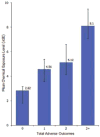1991 Gulf War exposures and adverse birth outcomes
- PMID: 23584910
- PMCID: PMC3930470
1991 Gulf War exposures and adverse birth outcomes
Abstract
We studied 1991 Gulf War (GW)-related environmental exposures and adverse birth outcomes in Iraqis. A random cross-sectional sample of 307 Iraqi families that immigrated to the United States responded to a structured interview covering socioeconomics, lifestyle, environmental exposures, and birth outcome. Data per each family was collected either from the man or the woman in the respective family. The respondents were divided into those that resided in Iraq during and following the GW (post-GW, n=185) and those that had left before (pre-GW, n=122). The primary outcome was lifetime prevalence of adverse birth outcomes, ie, congenital anomalies, stillbirth, low birth weight, and preterm delivery and its relationship to GW exposures. Mean number of adverse birth outcomes increased from 3.43 (SD=2.11) in the pre-GW to 4.63 (SD=2.63) in the post-GW group (P<.001). Mean chemical (Ch) and nonchemical (NCh) environmental exposure scores increased from pre-GW scores of 0.38 units (SD=1.76) and 0.43 (SD=1.86), respectively, to post-GW scores of 5.65 units (SD=6.23) and 7.26 (SD=5.67), P<.001 between groups for both exposures. There was a significant dose-response relationship between Ch environmental exposure (P=.001), but not NCh exposure, and number of adverse birth outcomes. Exposure to burning oil pits and mustard gas increased the risks for specific adverse birth outcomes by 2 to 4 times. Results indicate that Gulf War Ch, but not NCh exposures are related to adverse birth outcomes. Pregnancies in women with a history of war exposures might benefit from more intensive observation.
Figures



Similar articles
-
Neurotoxicant exposures and rates of Chronic Multisymptom Illness and Kansas Gulf War Illness criteria in Gulf War deployed women veterans.Life Sci. 2021 Sep 1;280:119623. doi: 10.1016/j.lfs.2021.119623. Epub 2021 May 15. Life Sci. 2021. PMID: 34004246
-
Health effects associated with geographical area of residence during the 1991 Gulf War: a comparative health study of Iraqi soldiers and civilians.US Army Med Dep J. 2011 Jul-Sep:87-96. US Army Med Dep J. 2011. PMID: 21805460 Free PMC article.
-
Birth defects in infants born in 1998-2004 to men and women serving in the U.S. military during the 1990-1991 Gulf War era.Birth Defects Res A Clin Mol Teratol. 2012 Sep;94(9):721-8. doi: 10.1002/bdra.23062. Epub 2012 Aug 18. Birth Defects Res A Clin Mol Teratol. 2012. PMID: 22903974
-
Gulf War illness: an overview of events, most prevalent health outcomes, exposures, and clues as to pathogenesis.Rev Environ Health. 2015;30(4):273-86. doi: 10.1515/reveh-2015-0032. Rev Environ Health. 2015. PMID: 26598939 Review.
-
Epidemiologic evidence of relationships between reproductive and child health outcomes and environmental chemical contaminants.J Toxicol Environ Health B Crit Rev. 2008 May;11(5-6):373-517. doi: 10.1080/10937400801921320. J Toxicol Environ Health B Crit Rev. 2008. PMID: 18470797 Review.
Cited by
-
Dysfunctional neuroplasticity in newly arrived Middle Eastern refugees in the U.S.: Association with environmental exposures and mental health symptoms.PLoS One. 2020 Mar 6;15(3):e0230030. doi: 10.1371/journal.pone.0230030. eCollection 2020. PLoS One. 2020. PMID: 32142533 Free PMC article.
-
Adverse effects of exposure to armed conflict on pregnancy: a systematic review.BMJ Glob Health. 2017 Nov 28;2(4):e000377. doi: 10.1136/bmjgh-2017-000377. eCollection 2017. BMJ Glob Health. 2017. PMID: 29333283 Free PMC article.
-
Midwives' Experiences of Caring for Ukrainian War Refugees: A Qualitative Study.Risk Manag Healthc Policy. 2025 Jul 28;18:2505-2514. doi: 10.2147/RMHP.S524572. eCollection 2025. Risk Manag Healthc Policy. 2025. PMID: 40757184 Free PMC article.
-
Conflict violence reduction and pregnancy outcomes: A regression discontinuity design in Colombia.PLoS Med. 2021 Jul 6;18(7):e1003684. doi: 10.1371/journal.pmed.1003684. eCollection 2021 Jul. PLoS Med. 2021. PMID: 34228744 Free PMC article.
-
"We are in this together" - Polish midwives' reflections on perinatal care for Ukrainian women after the outbreak of war.Health Psychol Rep. 2023 Apr 17;11(3):177-187. doi: 10.5114/hpr/161996. eCollection 2023. Health Psychol Rep. 2023. PMID: 38084265 Free PMC article.
References
-
- Stillerman K, Mattison D, Giudice L, Woodruff T. Environmental Exposures and Adverse Pregnancy Outcomes: A Review of the Science. Reprod Sci. 2008;15(7):631–650. - PubMed
-
- Wisborg K, Kesmodel U, Henriksen T, Olsen S, Secher N. Exposure to tobacco smoke in utero and the risk of stillbirth and death in the first year of life. Am J Epidemiol. 2001;154(4):322–327. - PubMed
-
- Shah PS, Balkhair T. Air pollution and birth outcomes: a systematic review. Environ Int. 2011;37(2):498–516. - PubMed
Publication types
MeSH terms
Grants and funding
LinkOut - more resources
Full Text Sources
